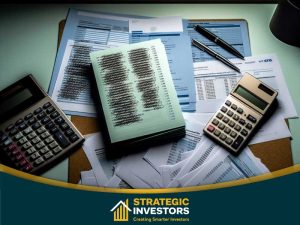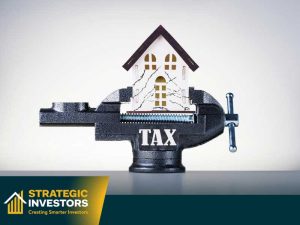
Calculating and minimizing capital gains tax on an investment property sale is a pivotal step in real estate investment strategy.
How much will you owe, and what can you do to lessen the impact on your returns?
This article provides direct, no-frills guidance on navigating the intricacies of ‘capital gain tax investment property’ issues, outlining what you need to know to understand and manage your potential tax liability effectively.
Key Takeaways
- Capital Gains Tax (CGT) is a levy on the profit from the sale of investment properties, and the rate depends on one’s marginal tax rate and may benefit from discounts or concessions. It is imperative for property investors to comprehend CGT implications, benefiting from strategies such as holding the property for over 12 months to qualify for a 50% discount.
- Calculating CGT involves determining the asset’s cost base and capital gain, including the purchase price and costs involved in buying, holding, and selling the property. Three methods of calculation are available: the ‘Other’ method, the ‘Discount’ method, and the ‘Indexation’ method, each with specific eligibility criteria.
- Several exemptions and strategies exist to minimize CGT, such as the Main Residence Exemption, the 6-Year Rule on rental properties, strategic timing of the sale, including expenses in the cost base, and utilizing capital losses. These can significantly lower the tax burden when managed correctly.
Understanding Capital Gains Tax on Investment Properties

Typically, your marginal income tax rate determines the rate of CGT. However, it can vary with potential discounts or concessions for certain types of assets.
What is Capital Gains Tax (CGT)?
Capital Gains Tax (CGT) is the profit you make on the sale of your real estate assets which is declared on annual income tax returns. CGT becomes relevant when you sell or dispose of your asset, specifically on the contract initiation date. At this point, you may need to pay capital gains tax depending on your specific situation.
The taxable profit for CGT is determined by the difference between the asset’s purchase price and sale price, inclusive of any extra costs.
How CGT Applies to Investment Properties
In Australia, CGT is applicable to profit generated from the sale of investment properties. It is triggered when a CGT event occurs, such as when the property is sold. For instance, if you sell your investment property within one year of purchase, the CGT will apply to 100% of the gains you made. The CGT is split between property owners according to their percentage of ownership documented in the title deed. Your residency status and your marginal income tax rate also play a significant role in the CGT calculation.
Even if you transfer your property to a relative or sell it at arm’s length to a third party, CGT remains applicable. The tax liability from a capital gains event must be declared in the tax return for the same financial year in which the contract of sale takes place.
Importance for Property Investors
In property investment, CGT isn’t just a tax; it’s a strategic component that can notably sway your net profits or losses from property transactions. Hence, understanding the tax implications when selling an investment property is paramount for investors to ensure they maximize their return on investment.
One way to significantly reduce your CGT liability is by holding onto your investment property for at least 12 months, thereby qualifying for the 50% CGT discount. This means only half of the gross capital gain needs to be declared as taxable income. The Australian Taxation Office (ATO) may treat your property for CGT based on its intended use, indicating the significance of your property’s investment strategy.
Calculating Capital Gains Tax for Investment Properties

You can calculate CGT using one of three popular methods: the Other method, the Discount method, and the Indexation method. These methods adjust the cost base for inflation, allowing you to avoid paying CGT on the inflation portion of the gain.
Determining Cost Base and Capital Gain
Your property’s cost base includes:
- The purchase price
- Incidental costs, including legal fees, stamp duty, and real estate agent’s commissions
- Capital expenses, like conveyancing costs, stamp duty, and legal fees incurred during the purchasing and improvement of the property
You can add these costs to your property’s cost base.
Maintaining detailed records of all expenses related to your property’s purchase, improvements, and sale is critical for accurate determination of the cost base for CGT calculations. The capital gain or loss is the difference between the property’s cost base and the amount received upon disposal, requiring a precise calculation of the cost base and understanding of sale proceeds.
Different Calculation Methods
In Australia, you can calculate the CGT using one of three methods: the ‘Other’ Method, the Discount Method, or the Indexation Method. The Indexation Method is relevant for assets acquired before 21 September 1999 and held for at least 12 months, enabling the cost base adjustment for inflation up to that date. You can calculate the indexation factor using the Consumer Price Index by dividing 68.7 (CPI for 30 September 1999) by the CPI when the cost was incurred and adjust the cost base of eligible expenses accordingly.
The decision between the Discount and Indexation methods depends on factors such as the asset type, ownership period, historical inflation rates, and existing capital losses. If you’re using the Discount Method, capital losses are deducted from capital gains prior to the application of the CGT discount.
The ‘Other’ method, a straightforward calculation of CGT, is used when the asset was owned for less than 12 months by subtracting the cost base from the capital proceeds.
Factors Affecting CGT Calculation
For co-owners of an investment property, CGT outcomes differ and depend on each co-owner’s stake in the property. Properties acquired before 20 September 1985 are exempt from CGT except for certain capital improvements made after that date. The ATO may consider the intention behind the purchase of a property when determining CGT, particularly if it was always meant as a rental investment. Your residency status during property ownership and at the time of sale influences CGT calculations and eligibility for exemptions.
CGT events are triggered in the following situations:
- When a property is lost or destroyed, occurring at the time of the first insurance payout or compensation receipt, or at the time of the loss if there’s no insurance.
- Trusts and super funds may be eligible for discounts.
- Companies cannot access the CGT discount.
The cost base for CGT calculation does not include costs that can be claimed as a tax deduction, such as capital works deductions.
The net capital gain, after discounts and loss offsetting, is added to an individual’s taxable income and taxed according to their marginal tax rate.
Exemptions and Discounts to Minimize Capital Gains Tax

The main residence exemption enables homeowners to evade CGT if their property serves as their primary residence. This exemption allows them to save on taxes when selling their home..
The 6-Year Rule allows a property that was the taxpayer’s main residence but is now rented out to be treated as the principal residence for CGT purposes for up to 6 years.
Moreover, if a property is held for over 12 months prior to its sale, the owner qualifies for a 50% CGT discount.
Main Residence Exemption
The main residence exemption shields homeowners from paying CGT on their primary residences. To be exempt from CGT under the main residence exemption, the dwelling must be the owner’s home for the entire period of ownership, not be used to produce income, and be on land of 2 hectares or less. If an investment property is converted to become the owner’s main residence, it may qualify for a full CGT exemption for the period during which it serves as the principal place of residence. However, keep in mind that foreign residents are generally not eligible for this exemption.
The profits made from selling a property that qualifies for the main residence exemption are exempt from CGT.
The 6-Year Rule
Under the ‘6-year rule’, an investor can classify a rental property as their main residence for CGT purposes for up to six years following its initial rental, possibly granting it a CGT exemption during this timeframe. To qualify for the 6-year rule, the property must have been established as the investor’s main residence prior to being used to generate rental income, and the owner must no longer reside in the property.
If the property is rented out for more than 6 years, it will be subject to CGT after the 6-year period, with the cost base being the property’s market value at the initial rental date plus any applicable costs incurred subsequently. However, if the property is not used to produce income after being vacated, it maintains its status as the main residence for CGT purposes indefinitely unless another property is designated as the main residence.
The ATO offers a partial exemption for a property that has served both as a rental and a main residence. This is done through the ‘Years Lived In vs. Years Rented’ calculation, adjusting CGT according to the duration the property functioned as each. If the property was used to produce income while simultaneously being used as the main residence, only a partial main residence exemption may apply, potentially increasing the CGT liability.
The 50% CGT Discount
Australian residents for tax purposes who have owned assets for at least 12 months prior to selling can avail the 50% CGT discount. Individuals and trusts can avail a 50% discount on CGT, whereas complying superannuation funds receive a 33.33% discount. However, companies are not eligible for any CGT discount.
For assets acquired before 21 September 1999, indexing the cost base for inflation is an alternative to obtaining a CGT discount, but both benefits cannot be combined. Investors in affordable housing who offer rental properties to low or moderate-income tenants for at least 3 years can receive an additional 10% CGT discount, totaling a 60% discount.
Inherited assets from deceased estates and assets transferred due to relationship breakdowns can have their previous ownership periods considered towards meeting the 12-month ownership requirement for the CGT discount. However, foreign or temporary residents are generally not eligible to claim the full CGT discount for capital gains made after 8 May 2012.
Strategies for Reducing Capital Gains Tax on Investment Properties

- Hold on to the asset for at least 12 months to avail the CGT discount, which can effectively halve your CGT liability.
- Increase the cost base of your property by adding expenses such as the remuneration for professional services, transfer costs, stamp duty, ownership costs like rates or land taxes, and costs associated with defending your title. This can help lower your CGT liability.
- Use a Capital Gains Reduction Report to identify and calculate the expenses that can be added to the cost base, ensuring the amount of capital gains declared for tax purposes is minimized.
Making strategic financial decisions such as investing in property when the mortgage is under control and there is a positive cash flow can also play a part in your overall strategy for mitigating CGT.
Timing the Sale
Timing is everything when it comes to selling your investment property. The CGT event’s timing for selling a rental property is determined by the contract initiation date, rather than the settlement date.
Timing the sale of an investment property to coincide with a year when your income is lower can prevent you from moving into a higher tax bracket and reduce your overall CGT liability.
Increasing Cost Base with Expenses
Considerably reducing your CGT liability can be achieved by increasing your property’s cost base. You can add expenses such as:
- Remuneration for professional services
- Transfer costs
- Stamp duty
- Ownership costs like rates or land taxes
- Costs associated with defending your title
Capital expenses that are incurred to prepare a property for rental, such as repairs and pest treatments, should also be added to the cost base, thereby increasing it and potentially reducing the CGT.
A quantity surveyor can assist you in preparing a Capital Gains Tax Reduction Report to determine which expenses qualify for inclusion in the cost base, such as incidental, ownership, and improvement costs. Keeping meticulous records of expenses and costs related to an investment property is crucial for minimizing the overall capital gain and maximizing potential tax benefits when calculating CGT.
Utilizing Capital Losses
Capital losses can be effectively utilized as a strategy to balance capital gains and minimize your overall CGT. A capital loss occurs when a capital asset is sold for less than its tax cost base. Capital losses must specifically be used to reduce capital gains and cannot be deducted from ordinary income.
If you have both capital gains and losses in a single financial year, the losses must be used to offset the gains, which can lower the overall CGT liability. Capital losses can be carried forward indefinitely, allowing you to offset future capital gains, but they cannot be used to offset other types of income.
Reporting and Paying Capital Gains Tax

It’s also important to know the documentation required for CGT reporting and calculations.
Reporting Capital Gains in Income Tax Return
In Australia, capital gains are reported under question 18 in the supplementary section of the individual tax return. Paper tax returns for individuals do not require a complete CGT schedule unless the return is for a company, trust, or fund. Reporting capital gains involves categorizing CGT assets and events, applying exemptions or rollovers, and calculating gains or losses to determine the net capital gain or loss.
If you have net capital gains included in trust distributions, you must report them, and as a beneficiary, you must use the calculation method applied by the trustee. Capital losses must be reported on the tax return in the year they are incurred or carried forward to offset future gains. If you are a foreign resident selling property for $750,000 or more, you are subject to a 12.5% Foreign resident capital gains withholding unless you obtain a clearance certificate.
Foreign residents cannot claim the main residence exemption for CGT events if they were not Australian residents for tax purposes while living in the property.
Payment Deadlines and Penalties
Note that if the CGT payment due date falls on a weekend or public holiday, payments can be made on the subsequent business day without attracting a penalty.
Also, failing to pay any owing land tax on an investment property before selling it can result in financial or legal penalties.
Required Documentation
Maintaining accurate records is crucial when dealing with CGT. Here are some important points to remember:
- The time of a CGT event, which is crucial for tax purposes, is determined by the contract of sale date rather than the settlement date.
- The ATO mandates that individuals retain detailed records related to CGT events for at least 5 years.
- All records kept for CGT purposes must be in English or easily translatable into English.
- Records should clearly outline the nature, date, participants, and relevance of the transactions to capital gains or losses.
For tax reporting and consultations with tax advisors, you should collect all pertinent documentation, including property management records, purchase and sale contracts, and records of expenses. Keeping accurate records of both capital gains and losses is essential for investors, as these records enable the strategic use of losses to offset capital gains for tax minimization.
Tax Implications of Rental Income and Expenses

Taxable Rental Income
In Australia, rental income augments an investor’s assessable taxable income and is taxed at their marginal tax rate. If a property is positively geared, meaning rental income exceeds the property expenses, it results in increased taxable income and therefore higher taxes. However, tax losses, which occur when deductions exceed income, differ from capital losses and have different rules regarding their use.
Deductible Expenses
As a property investor, you can claim tax deductions on expenses related to your rental property, including:
- Interest on investment home loans
- Any associated loan fees
- Repairs and maintenance expenses (when they are for restoring the item to its original condition and do not represent an improvement)
- Depreciation of both the building structure and features of a rental property (a depreciation schedule prepared by a Quantity Surveyor is required for this purpose)
Additional deductible expenses for property investors include:
- Advertising for tenants
- Strata fees
- Council rates
- Utility bills
- Property management fees
- Some legal fees
- Stationery
- Travel costs
- Land tax
- Pest control
Impact on Capital Gains Tax
Expenses incurred to generate rental income can decrease the investment property’s cost base, potentially raising the taxable capital gain. Claiming expenses related to a rented portion of a PPOR, like a granny flat, can affect the overall CGT when the property is sold. The cost base of a property does not incorporate amounts that have been claimed as tax deductions, such as capital works deductions and decline in value deductions, influencing the CGT calculation upon sale.
For properties located overseas, CGT calculations are based on the property’s market value at the time the owner became a tax resident of Australia if the sale happens while they are non-residents for tax purposes.
Seeking Professional Advice

Benefits of Professional Advice
A qualified tax professional can offer personalized advice suited to your unique circumstances. This helps to ensure full compliance with tax laws and maximizes potential tax benefits.
It can also help you understand the complexities of CGT and how to effectively navigate it to reduce your tax liability.
Finding the Right Advisor
When seeking advice on property investment, it’s vital to choose a professional with extensive experience and a proven track record across several property cycles. A good property advisor will focus on long-term financial goals, remove anxiety by simplifying complex concepts, and ensure their clients understand the risks as well as the rewards of property investment.
The relationship with a property advisor should be long-term, with regular reviews of property portfolio performance to ensure alignment with financial objectives.
Preparing for Consultation
Ahead of the consultation, it’s important to gather all necessary financial records, including purchase and sale contracts, expenses records, and details of any capital improvements to the property. Knowledge of various investment strategies such as buy-and-hold, flipping, or utilizing a property as a short-term rental can have different tax outcomes, and understanding these can enhance the productivity of the consultation.
Presenting a clear picture of one’s personal financial situation, including income, expenses and financial goals, allows the tax consultant to provide more precise and beneficial guidance.
Summary
In conclusion, understanding CGT and its implications on property investment is vital for any property investor. From calculating CGT to utilizing strategies to minimize it, every aspect plays a significant role in your overall return on investment. Remember, a well-informed investor is a successful investor. So, keep yourself updated, seek professional advice, and turn your property investment into a success story.
Frequently Asked Questions

How can I avoid capital gains tax on investment property?
To avoid capital gains tax on your investment property, consider owning the property for at least 12 months to qualify for a 50% CGT discount and maintain it as your primary residence (PPOR), even if you’re not living there. Remember the 6-year rule for the main residence exemption.
How much capital gains tax do I pay on sale of investment property?
You would pay capital gains tax at the same rate as your taxable income, which means if you made a capital gain of $100,000 with an income tax rate of 20%, you’d pay $20,000 in capital gains tax.
What is the 6 year rule for capital gains tax?
The CGT Six-Year Rule allows you to treat your property investment as your principal place of residence for up to six years while renting it out, potentially reducing your capital gains tax.
What is Capital Gains Tax (CGT)?
Capital Gains Tax (CGT) is the profit made from the sale of real estate assets and is reported on annual income tax returns.
How does CGT apply to investment properties?
CGT applies to investment properties in Australia when a profit is made from their sale, triggering a CGT event.













